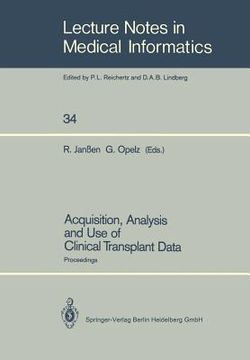Share
acquisition, analysis and use of clinical transplant data: proceedings (in English)
Gerhard Opelz
(Illustrated by)
·
Springer
· Paperback
acquisition, analysis and use of clinical transplant data: proceedings (in English) - Janßen, Rainer ; Opelz, Gerhard
$ 52.09
$ 54.99
You save: $ 2.90
Choose the list to add your product or create one New List
✓ Product added successfully to the Wishlist.
Go to My WishlistsIt will be shipped from our warehouse between
Wednesday, June 12 and
Thursday, June 13.
You will receive it anywhere in United States between 1 and 3 business days after shipment.
Synopsis "acquisition, analysis and use of clinical transplant data: proceedings (in English)"
Computer applications in medical care have been greatly increasing during the last ten years. Combined with other electronic devices, computers can produce images which represent human organ sections. Such a way to get informations on patient organs widely improves di- agnosis and surgery efficiency. But we can go through a new step by generating three- dimensional models of these organs and by displaying them. Most of research in this area focuses on the visualization process. But, in order to efficiently exploit the data collected and processed by the computer, we need to create a high-level three-dimensional model of the organ to be displayed. An interactive approach to get such a model is described in this paper as the way to use it for the study of kidney anatomy. I. 20 and 30 data visualization in medical care Classical X-ray radiographs give us a projection of human body inner parts, with an enhancement of high-density elements. But they cannot give us a complete view of organs, such as in cross-sections. Recent imaging techniques solve this problem, usually by computing those sections from a set of projections along different directions. Physicians can then get a full examination of organs by using such equipments as X-ray scanners or those producing Mag- netic Resonance, ultrasonic or radionuclide images. The information collected on the organ (density, acoustic property, etc.
- 0% (0)
- 0% (0)
- 0% (0)
- 0% (0)
- 0% (0)
All books in our catalog are Original.
The book is written in English.
The binding of this edition is Paperback.
✓ Producto agregado correctamente al carro, Ir a Pagar.

